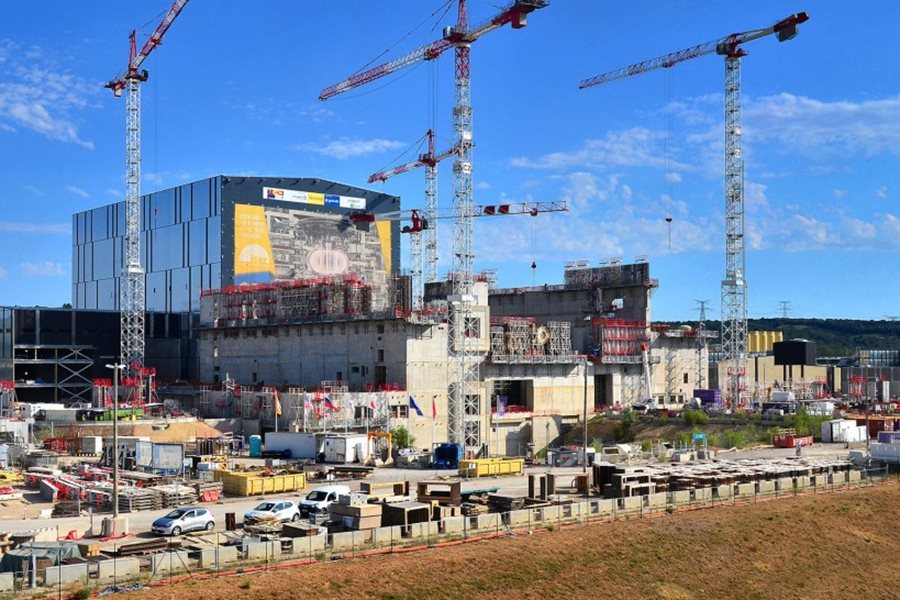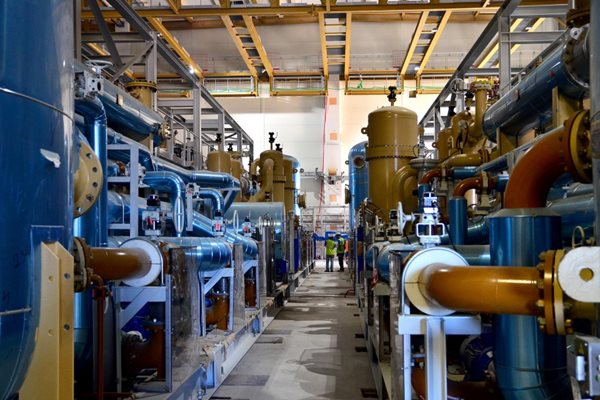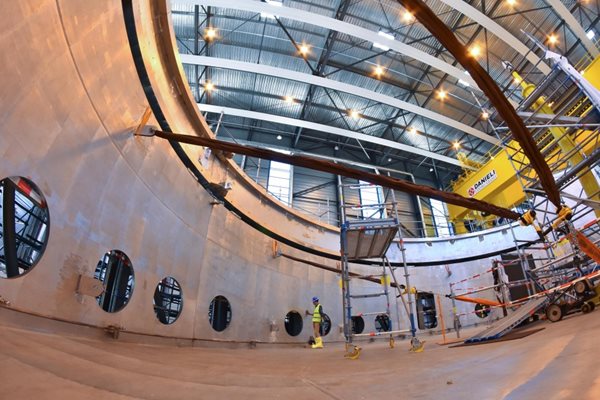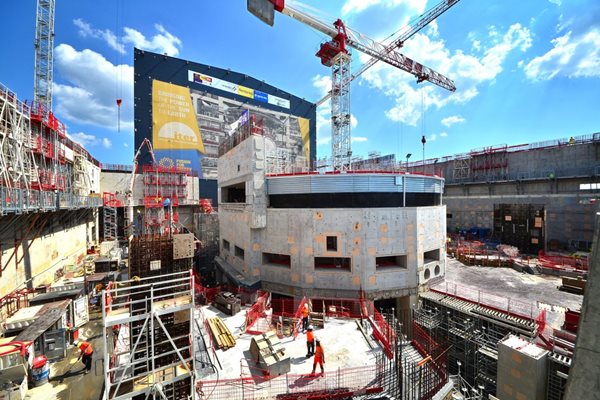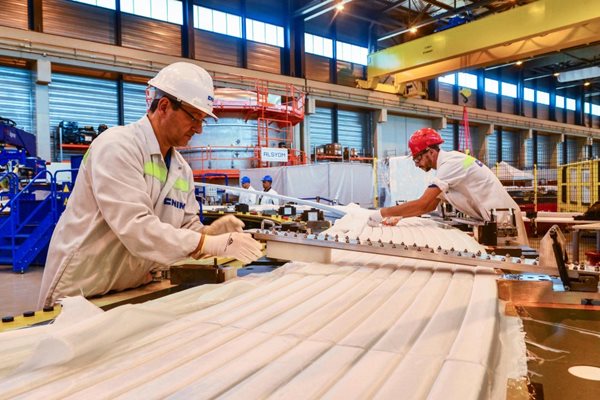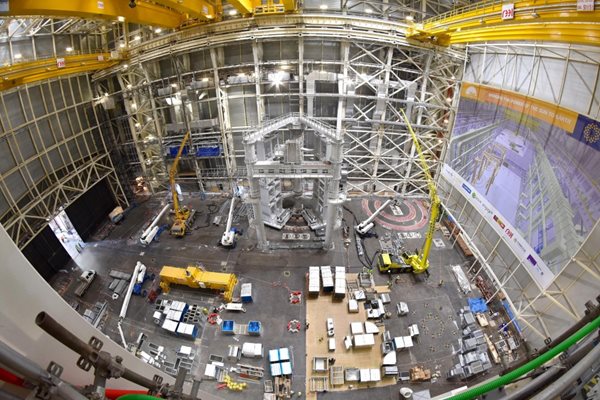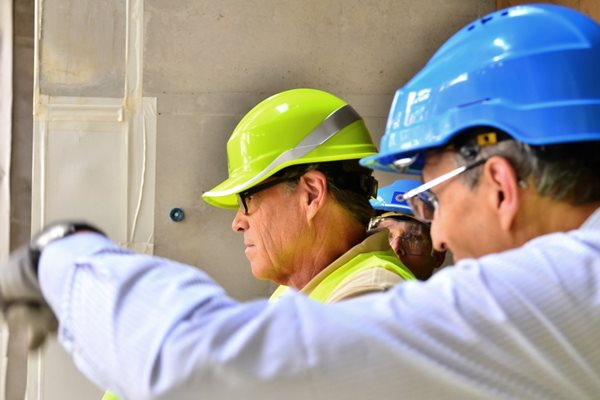
you're currently reading the news digest published from 16 Jul 2018 to 23 Jul 2018
featured7
press6
featured
Summer postcards
A building that, from a certain angle, looks like the bow of a spaceship; a handling tool that evokes a mechanical Titan, slowly opening and closing giant arms; a steel-lined room that seems to open out onto the star-studded firmament; an intricate mass of pipes, pumps and tanks resembling the innards of a large marine creature ... All in all, the ITER worksite can be an astonishing visual experience. This last issue of Newsline before our traditional summer break (we'll be back on 3 September) offers a guided tour of the main activities underway on site: the building of the 'crown' on the floor of the Tokamak Building; the fabrication of the first poloidal field coil and the cryostat; and ongoing works in the cryoplant and Assembly Hall. To this visual journey, we've added a brief report on the recent visit of the US Secretary of Energy, Rick Perry. Like many, he was positively impressed by what he saw.
Cryoplant | Filled from floor to ceiling
The ITER cryoplant used to be a vast echoey chamber with 5,400 m² of interior space divided into two areas; now, it is filled from floor to ceiling with industrial equipment. Three parties are sharing responsibility for the plant's procurement: the ITER Organization, responsible for the liquid helium plants; Europe, in charge of the liquid nitrogen plant and auxiliary systems as well as the construction of the cryoplant infrastructure on site; and India, whose contractors are procuring the cryolines and cryodistribution components. The installation of helium compressor skids on concrete pads was completed earlier this year. Aligned in three rows, each one linked to a helium cold box, the compressors will supply the cold boxes with gaseous helium at 21.8 bars and eventually provide the necessary gas flow for the supercritical helium cooling needs of the Tokamak. Team members can be seen standing on the pads in this picture, four metres above ground level. As a final installation step, a special grouting—part cement, part resin—will be poured to federate the pad and the skid into a mechanically homogeneous structure. Most of the planned components are now installed in the Compressor Building, drastically reducing the space for circulation. Here, a corridor has been created between the huge oil removal system skids of two rows of the liquid helium plant compression station. For the nitrogen plant, the first phase of centrifugal compressor installation was achieved this month. These compressors (which, at 4.5 MW, are the biggest of the cryoplant) are also housed in the Compressor Building, next to the 18 compressors that will be required for the operation of the helium refrigerators. This month, the compressors were pre-aligned with their motors and after-coolers/associated piping were installed. Close coordination is required of the different teams that are active in the cryoplant. Co-activity issues are addressed and resolved in dedicated coordination meetings, or in more informal meetings on site. In this picture, representatives of various stakeholders (the ITER Organization, the European Domestic Agency, equipment manufacturer Air Liquide, mechanical installation contractors, and ITER's Construction Management-as-Agent) are assessing potential difficulties in co-activity related to the installation of helium storage gasbags up near the roof at the same time as some HVAC (ventilation) equipment.
Cryostat | Adjusting, welding, testing ...
The assembly of the ITER cryostat—the stainless steel "thermos" that insulates the ultra-cold superconducting magnets from the environment—is progressing in an on-site workshop under the responsibility of the Indian Domestic Agency. Indian procurement scope includes the fabrication, assembly, welding and testing of four major sections (the base, lower cylinder, upper cylinder and top lid) as well as the installation and welding of the entire structure in the machine assembly "pit." Main contractor Larsen & Toubro Heavy Engineering has been tasked by the Indian Domestic Agency with the manufacturing design, fabrication and assembly of the cryostat. The base section of the cryostat resembles a soup plate, with a deep bottom, vertical walls and a wide rim. In the picture above, the vertical walls have been trial fitted between the bottom plate (where the person is standing) and the top rim (which begins above the gap) for inspection. Following inspection, the wall segments were disassembled. Adjustments are being made as seen above with a high-performance plasma torch. Once reassembled and welded into place, the full cryostat base will weigh 1,250 tonnes—the heaviest single component to be lowered by the overhead cranes into the machine assembly well in the Tokamak Building. The lower cylinder of the cryostat—30 metres in diameter, 490 tonnes—has been completely assembled. During the welding operations of the last months, approximately 200 metres of circular and vertical welds were carried out. When all activities on this cryostat section conclude, it will be moved from the Cryostat Workshop to a protected location on the platform to make room for the upper cylinder segments that will be arriving from India. It took approximately four weeks to verify half of the vacuum welds of the lower cylinder. Different specific ultrasonic examination probes are being used by Larsen & Toubro specialists to cover various angles and depth ranges.
Tokamak Building | Full steam ahead
In this central arena of the construction site, construction teams are active three shifts a day—two full work shifts and a third, at night, dedicated to moving scaffolding and formwork in preparation for the next day's tasks. Responsible for civil engineering and construction, the European Domestic Agency is working to meet an important date on the ITER calendar—March 2020, when the first limited crane access between the Assembly Hall and the Tokamak Building is needed for major installation activities. In the months ahead there will be increased co-activity in the area, as building teams continue to execute civil works contracts (2,000 people currently) at the same time as ITER Organization contractors begin on installation activities. The ITER Organization is preparing now to tender the principal contracts related to assembly and installation works. The bioshield—the six-level, 30-metre-tall structure at the centre of the Tokamak Building—was completed earlier this year. The ITER machine will be assembled within its walls in a bottom-up fashion, beginning with the cryostat base; for now, the bioshield is capped with a temporary lid to protect workers active down in the basement levels of the structure. When the Tokamak Building rises all around (matching the height and width of the Assembly Hall in the background) the temporary lid will be removed, the fabric wall (in black) will come down, and the crane rails will be extended over the Tokamak "pit." Only then can the heavy lift activities commence. In the bowels of the Tokamak Building is a peculiar chamber—the drain tank room. Fifteen metres wide, and 11 metres high, it is designed to house seven water storage tanks required for the operation of the machine's cooling water and vacuum vessel pressure suppression systems. Tall sheets of stainless steel cover the lower walls and floor (covered now, to protect from paint), and 800 embedded plates have been installed to anchor equipment. Contractors have just finished painting the walls of the room; in August, the tanks will be installed one after another through the opening in the roof. At the bottom of the Tokamak Pit, we can now distinguish an inner circle of concrete plus radial walls. This is the concrete "crown" that will support the machine from below and transfer forces generated during operation to the massive bioshield and the ground. The cryostat base—the first major "piece" in the assembly puzzle of the ITER machine—will "sit" on this wall, with the deep bottom of the base occupying the inner circle while the outer pedestal rim will be supported on the crown wall (on bearings) and also on the "lip" of concrete now hidden by rails for the circular crane. Four concrete pours are needed to realize the full crown; two have been realized and a third is planned late July. And finally, in this view from a tall crane ... we see that the bioshield is not quite the circular structure we often describe, but is rather built from 18 plane surfaces, or facets. Teams are active all around the central structure at level 3 (L3) of the Tokamak Building. On the far side, for example, teams are pouring heavy borated concrete in parts of the building that require special shielding from neutrons.
Poloidal field coils | Turning tables and hot resin
One of only two manufacturing facilities located on the ITER site, the Poloidal Field Coils Winding Facility was constructed by Europe to house the winding, impregnation and assembly activities for ITER's largest ring-shaped magnets. Manufacturing is underway now on a 17-metre-in-diameter poloidal field coil called PF5. In the first step of the process, the raw material—niobium-titanium conductor—is wound into a flat, double-layer, spiralled coil called a double pancake. Several layers of glass-fibre tape are applied as the conductor enters the winding table to insulate the conductor turns from one another. In this photo, European contractors are winding the sixth in the series of eight double pancakes required by PF5. The winding table rotates slowly as conductor is fed simultaneously from two spools in a process known as "two-in-hand" winding. After completing the winding, the next step is to shape the "terminations"—the areas that connect one conductor length electrically to another, or one double pancake to another. A portion of conductor is opened, the turn insulation is removed and moulds are brought close to the double pancake to shape its end into a "termination joggle." The creation of a termination box comes next. The box is welded to the jacket of conductor on one end with a stainless steel pipe for liquid helium cooling exiting on the other end. The double pancakes are then transported by overhead crane to the vacuum pressure impregnation station and lowered into a custom-fit mould. Epoxy resin, injected over the course of several hours, fills all gaps and hardens the glass-fibre tape under the effect of heat and pressure. A 36-hour "curing" phase at 140 °C completes the process, which gives the double pancake rigidity and ensures electrical insulation. During this process the conductor ends, which carry the terminations to be used for joints between the double pancakes, are isolated by an "insulation breaker," which keeps the resin from binding these areas. In this picture, one double pancake is undergoing impregnation in the background, while assembly is underway on the impregnation mould for another. The final step is cold testing. Once the eight double pancakes for PF5 are stacked and assembled to form the complete winding pack, a second vacuum impregnation is performed to harden the entire assembly. The manufacturing process then ends with cold testing, during which the completed coil is cooled to low temperature (approximately 80 K) in order to simulate the thermal stresses and the work conditions that will be experienced during operation. In this way, the performance of the coils will be tested before their installation in the ITER machine.
Assembly Hall | One giant standing
Two identical handling tools in the Assembly Hall will play a critical role in preparing ITER's nine vacuum vessel sectors for their final journey: transport by overhead crane into the Tokamak Pit. Called the sector sub-assembly tools (SSAT) they will support a sector vertically while operations that can only take place in a spacious area—the addition of large thermal shielding sections and the attachment of a pair of D-shaped toroidal field magnets—are carried out. These tools must be commissioned before the first vacuum vessel sector arrives from Korea in early 2019. The first tool is fully assembled on the shop floor. The 800-tonne metal structure of SSAT#1 has now been installed in the Assembly Hall. The first segments of SSAT#2 have also arrived on site, ready to be installed on the anchoring elements adjacent to the first tool. Both tools have been procured by the Korean Domestic Agency, which is in charge of the design and fabrication of over three dozen dedicated assembly tools. As part of functional tests planned on the SSAT tools, test loads of 340 tonnes (just over the weight of a toroidal field coil) will be attached to each of the lateral wings to be rotated inward. The sector sub-assembly tools will support charges of up to 1,200 tonnes during out-of-pit pre-assembly activities. The precise actuator system of these hydraulic-powered tools will allow components to be positioned with the highest accuracy—just 1.5 mm for the toroidal field coils that are 16 metres tall, for instance—and adjusted to six degrees of freedom (up and down, side to side, forward and backward, plus rotational directions (swivel, tilt, pivot) relative to the axes). The pre-assembly operations on the first-delivered vacuum vessel sector are expected to take the longest. With lessons learned--and two tools operating in tandem—the necessary time will be reduced significantly.
Visit | US Energy Secretary Rick Perry gets first-hand look at ITER
Marking an important step in the US review of ITER Project progress, on Wednesday 11 July ITER Organization received a visit from the Head of the United States Department of Energy, Secretary Rick Perry. The most senior US Administration official to ever visit the ITER Project, Mr Perry was accompanied by key members of his staff, as well as the US Ambassador to France, Jamie McCourt. As Secretary Perry put it, this first-hand look at ITER construction and manufacturing will give him the insights and information needed to contribute credibly to discussions in Washington about the US role in ITER. It is a responsibility Secretary Perry takes seriously. He spent considerable time meeting with Director-General Bigot and several ITER managers, conducted a meticulous walking tour of the worksite, and set aside time to meet and answer questions with the US-origin ITER staff. Secretary Perry is no stranger to big projects. As the longest serving Governor of the State of Texas, from December 2000 to January 2015, he presided over one of the largest expansions of renewable energy in history, significantly reducing carbon dioxide and other harmful emissions statewide and securing a broad energy mix including nuclear plants. Nor is Perry a stranger to France. In his first elected role, as the Texas Commissioner of Agriculture, he established extensive ties to French agricultural and viniculture programs. And he proudly reminded Director-General Bigot of the longstanding tradition of collaboration between France and Texas, extending back historically to the Republic of Texas (before its annexation as a US State), and the French 'legation' (similar to an embassy), built in 1841, that still stands in Austin, not far from the Texas capitol building. In discussions following the worksite visit, Secretary Perry made clear how positively impressed he was with the substantive progress made during the past three years: the solid evidence of strong project management, and the dedication of the ITER Organization's staff to bringing the project in on cost, on schedule, and on specification. He took particular note of the broad range of US companies fabricating ITER components and the associated high-tech US jobs and innovation coming from participation in the project. As Director-General Bigot noted, it is ITER's ambition to serve as a model of successful international collaboration—and as a 'smart deal' and positive return on investment for the US and all ITER Members.
